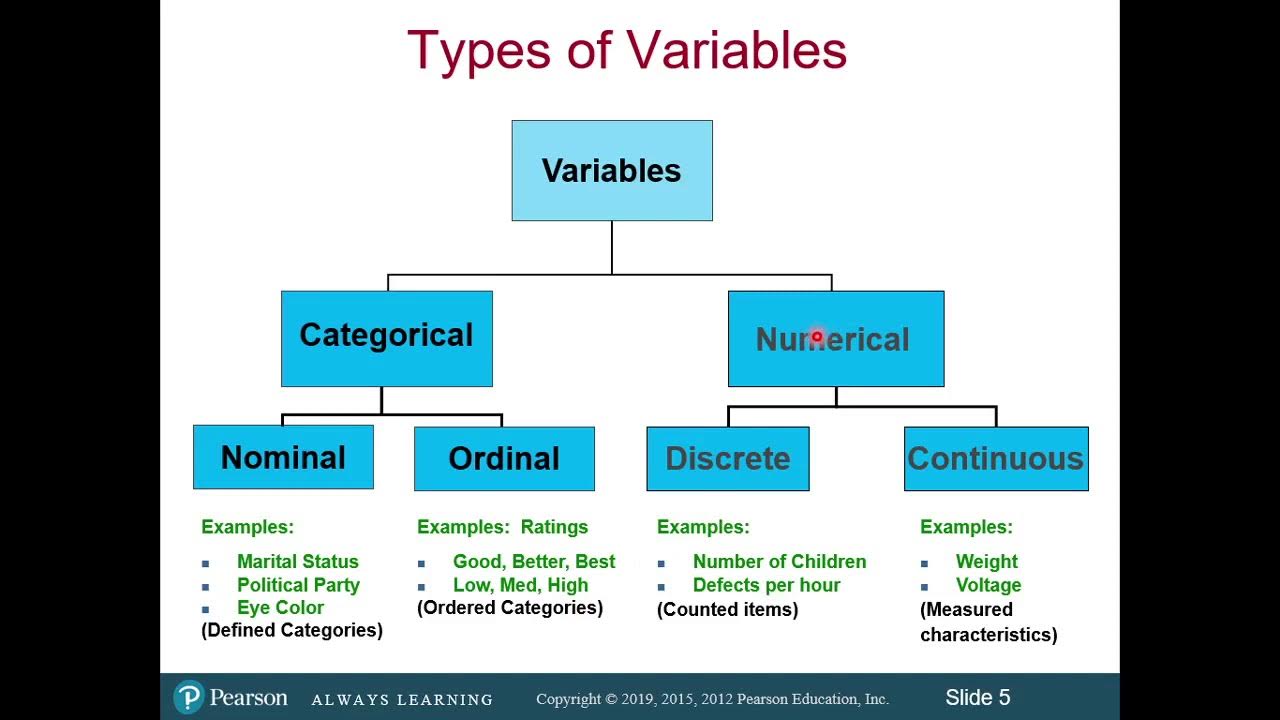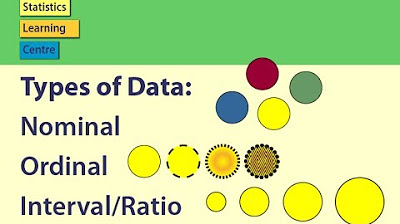Variables and Types of Variables | Statistics Tutorial | MarinStatsLectures
TLDRThis transcript delves into the fundamentals of statistics, focusing on the concept of variables. It explains that variables, which can be categorical or numeric, are used to collect and analyze data about a population. Categorical variables are further divided into nominal and ordinal, with nominal lacking order and ordinal having a ranking system. Numeric variables are categorized as discrete or continuous, with discrete variables taking on integer values and continuous variables being measured on an unbroken scale. The importance of distinguishing between variable types for data analysis and summarization is emphasized, with categorical variables often summarized by proportions and percentages, while numeric variables might be summarized by mean or median.
Takeaways
- 📊 Statistics is fundamentally about collecting data to make generalizations about a population.
- 🔍 A variable is a recorded piece of information or characteristic that varies from person to person, such as age or weight.
- 📈 Variables are categorized into two main types: categorical (qualitative) and numeric (quantitative).
- 🏷️ Categorical variables place individuals into groups or categories and can be further divided into nominal (no order) and ordinal (ordered).
- 🔢 Numeric variables record quantities and can be discrete (integer values) or continuous (measured on a scale).
- 👤 Examples of categorical variables include biological sex, country of birth, and hair color, while examples of numeric variables include age, weight, and income.
- 📝 Categorical variables are sometimes recorded using numbers (e.g., 0s and 1s), but they remain categorical, not numeric.
- 📊 Numeric variables can be measured on ratio scales (e.g., age, weight) or interval scales (e.g., temperature in Celsius or Fahrenheit).
- 🔄 Numeric variables can be converted into categorical variables by grouping them into categories (e.g., age groups).
- 📊 The type of variable (categorical, numeric, or a combination) influences the choice of appropriate summaries and analysis methods.
- 📈 Categorical variables are often summarized using proportions or percentages, while numeric variables can be summarized using mean or median.
Q & A
What is the primary goal of statistics?
-The primary goal of statistics is to collect data, record variables, and use this information to make generalizations about a population.
What is a variable in the context of statistics?
-A variable is a recorded piece of information or characteristic about a person, case, or unit in a study, which varies or changes from one individual to another.
What are the two broad categories of variables?
-The two broad categories of variables are categorical (also known as qualitative) and numeric (also known as quantitative).
How can categorical variables be further classified?
-Categorical variables can be further classified into nominal and ordinal. Nominal variables do not have any order or ranking, while ordinal variables have a specific order or ranking to their categories.
What are the differences between discrete and continuous numeric variables?
-Discrete numeric variables can only take on integer values and can theoretically go up to infinity, such as the number of people in an emergency room. Continuous numeric variables are measured on a continuous scale, like weight, which can have decimal values.
Why are categorical variables sometimes recorded using numbers?
-Categorical variables are sometimes recorded using numbers for ease of data entry and organization, but this does not make them numeric variables. The numbers serve as placeholders or labels for the categories.
How can numeric variables be converted into categorical variables?
-Numeric variables can be converted into categorical variables by breaking them down into groups or categories, such as classifying age into child, adult, and senior categories.
What are ratio and interval scales of measurement?
-Ratio scales have a meaningful zero and allow for the calculation of meaningful ratios, like age or weight. Interval scales have a non-meaningful or arbitrary zero and do not allow for meaningful ratios, like temperature in degrees Celsius or Fahrenheit.
How are identifiers different from variables?
-Identifiers, such as student numbers or employee IDs, are used to uniquely identify individuals but do not represent variables. They are not characteristics or measurements of the individuals but are used for organizational purposes.
How do different types of variables influence the choice of statistical summaries and analysis methods?
-The type of variable (categorical, numeric, discrete, continuous) influences the choice of statistical summaries and analysis methods. For example, categorical variables might be summarized using proportions or percentages, while numeric variables could be summarized using mean or median.
What is the significance of understanding variable types in statistics?
-Understanding variable types is crucial for selecting appropriate statistical summaries and analysis methods. It ensures that the data is accurately represented and that the conclusions drawn from the data are valid and meaningful.
Outlines
📊 Introduction to Variables in Statistics
This paragraph introduces the concept of variables in statistics, explaining their role in collecting and analyzing data. It defines a variable as a recorded piece of information or characteristic about a person or unit in a study, which varies from person to person. The paragraph emphasizes the importance of understanding the type of variables, as this influences how data is summarized and analyzed. It outlines the two broad categories of variables: categorical (also known as qualitative) and numeric (quantitative). Categorical variables place people into categories or record qualities, while numeric variables record quantities. The paragraph also introduces the further classification of variables into nominal, ordinal, discrete, and continuous, providing examples for each type and setting the stage for further discussion on variable types and their analysis.
🔢 Classification and Measurement of Variables
This paragraph delves deeper into the classification of variables, discussing how categorical variables can be nominal or ordinal, and numeric variables can be discrete or continuous. It provides examples of each type, such as biological sex and country of birth for nominal variables, and the size of coffee orders for ordinal variables. The paragraph also explains the difference between discrete and continuous numeric variables, with the former taking on integer values and the latter being measured on a continuous scale. It highlights the importance of recognizing that categorical variables sometimes use numbers but remain categorical, not numeric, and that numeric variables can be converted into categorical variables. The paragraph concludes by noting that the type of variable used significantly impacts the choice of data analysis methods and plots.
📈 Understanding Scales of Measurement
The final paragraph focuses on the scales of measurement for variables, specifically ratio and interval scales. It explains that ratio scales, such as age, weight, and income, have a meaningful zero and allow for comparison of ratios, like twice as old or twice as much. In contrast, interval scales, like temperature in Celsius or Fahrenheit, have an arbitrary zero and do not support meaningful ratio comparisons. The paragraph also touches on the use of identifiers, like student numbers, which are not variables but are used to identify individuals. It concludes by reiterating the importance of correctly categorizing variables and understanding their scales of measurement for effective data analysis and summarization, and encourages viewers to follow for more insights into statistical analysis.
Mindmap
Keywords
💡Statistics
💡Variable
💡Categorical Variable
💡Numeric Variable
💡Nominal
💡Ordinal
💡Discrete
💡Continuous
💡Ratio Scale
💡Interval Scale
💡Identifiers
Highlights
Statistics involves collecting data and making generalizations about a population.
A variable is a recorded piece of information or characteristic about a person or unit in a study.
Variables can be categorical, placing people into categories, or numeric, recording quantities.
Categorical variables can be further divided into nominal (no order) and ordinal (ordered) categories.
Numeric variables can be discrete, like counting people, or continuous, like measuring weight.
The type of variable affects how data is summarized and analyzed.
Categorical variables are sometimes recorded with numbers but remain categorical, not numeric.
The Likert scale is an example of an ordinal variable where numbers represent categories of agreement or disagreement.
Numeric variables can be converted into categorical variables, like breaking age into child, adult, and senior categories.
Identifiers like student numbers are used to identify individuals but are not considered variables.
Discrete variables take on integer values and can theoretically go to infinity.
Continuous variables are measured on a scale without discrete jumps, like temperature in degrees Celsius or Fahrenheit.
Ratio scales have a meaningful zero and allow for comparison of ratios, like age or weight.
Interval scales have an arbitrary zero and do not allow for meaningful ratio comparisons, like temperature in degrees Celsius or Fahrenheit.
Categorical variables are often summarized using proportions or percentages.
Numeric variables are summarized using measures like mean or median.
Appropriate summaries and analysis methods depend on whether the variables are categorical or numeric.
Transcripts
Browse More Related Video

Classification of Variables and Types of Measurement Scales

Different Variables in Quantitative Research~GM Lectures

Types of Data: Nominal, Ordinal, Interval/Ratio - Statistics Help

Introduction to Statistics (1.1)

Categorical vs Quantitative Variables

Plots for Two Variables | Statistics Tutorial | MarinStatsLectures
5.0 / 5 (0 votes)
Thanks for rating: